Table of Contents
1. Systems Engineering and the World of Modern Systems
1.1 What is Systems Engineering?
1.2 The Systems Engineering Landscape
1.3 Systems Engineering Viewpoint
1.4 Perspectives of Systems Engineering
1.5 Examples of Systems Requiring Systems Engineering
1.6 Systems Engineering Activities and Products
1.7 Systems Engineering as a Profession
1.8 Systems Engineer Career Development Model
1.9 Summary
Problems
References
Further Reading
2. Structure of Complex Systems
2.1 System Elements and Interfaces
2.2 Hierarchy of Complex Systems
2.3 System Building Blocks
2.4 The System Environment
2.5 Interfaces and Interactions
2.6 Complexity in Modern Systems
2.7 Summary
Problems
Reference
Further Reading
3. The System Development Process
3.1 Systems Engineering Through the System Life Cycle
3.2 System Life Cycle
3.3 Evolutionary Characteristics of the Development Process
3.4 The Systems Engineering Method
3.5 Testing Throughout System Development
3.6 Summary
Problems
Reference
Further Reading
4. Systems Engineering Management
4.1 Managing System Development
4.2 Work Breakdown Structure
4.3 Systems Engineering Management Plan
4.4 Organization of Systems Engineering
4.5 Summary
Problems
Further Reading
5. Needs Analysis
5.1 Originating a New System
5.2 Systems Thinking
5.3 Operations Analysis
5.4 Feasibility Definition
5.5 Needs Validation
5.6 Summary
Problems
References
Further Reading
6. Requirements Analysis
6.1 Developing the System Requirements
6.2 Requirements Development and Sources
6.3 Requirements Features and Attributes
6.4 Requirements Development Process
6.5 Requirements Hierarchy
6.6 Requirements Metrics
6.7 Requirements Verification and Validation
6.8 Requirements Development: TSE vs. Agile
6.9 Summary
Problems
Further Reading
7. Functional Analysis
7.1 Selecting the System Concept
7.2 Functional Analysis and Formulation
7.3 Functional Allocation
7.4 Functional Analysis Products
7.5 Traceability to Requirements
7.6 Concept Development Space
7.7 Summary
Problems
Further Reading
8. Evaluation and Selection
8.1 Evaluating and Selecting the System Concept
8.2 Alternatives Analysis
8.3 Operations Research Techniques
8.4 Economics and Affordability
8.5 Events and Decisions for Consideration
8.6 Alternative Concept Development and Concept Selection
8.7 Concept Validation
8.8 Traditional vs. Agile SE Approach to Concept Evaluation
8.9 Summary
Problems
References
Further Reading
9. Systems Architecting
9.1 Architecture Introduction
9.2 Types of Architecture
9.3 Architecture Frameworks
9.4 Architectural Views
9.5 Architecture Development
9.6 Architecture Traceability
9.7 Architecture Validation
9.8 Summary
Problems
Further Reading
10. Model‐Based Systems Engineering (MBSE)
10.1 MBSE Introduction
10.2 MBSE Languages
10.3 MBSE Tools
10.4 MBSE Used in the SE Life Cycle
10.5 Examples
10.6 Summary
Problems
References
Further Reading
11. Decision Analysis and Support
11.1 Decision Making
11.2 Modeling Throughout System Development
11.3 Modeling for Decisions
11.4 Simulation
11.5 Trade Off Analysis
11.6 Evaluation Methods
11.7 Summary
Problems
References
Further Reading
12. Risk Management
12.1 Risk Management in the SE Life Cycle
12.2 Risk Management
12.3 Risk Traceability/Allocation
12.4 Risk Analysis Techniques
12.5 Summary
Problems
Reference
Further Reading
13. Advanced Development
13.1 Reducing Uncertainties
13.2 Requirements Analysis
13.3 Functional Analysis and Design
13.4 Prototype Development as a Risk Mitigation Technique
13.5 Development Testing
13.6 Risk Reduction
13.7 Summary
Problems
References
Further Reading
14. Software Systems Engineering
14.1 Components of Software
14.2 Coping with Complexity and Abstraction
14.3 Nature of Software Development
14.4 Software Development Life Cycle Models
14.5 Software Concept Development: Analysis and Design
14.6 Software Engineering Development: Coding and Unit Test
14.7 Software Integration and Test
14.8 Software Engineering Management
14.9 Summary
Problems
References
Further Reading
15. Engineering Design
15.1 Implementing the System Building Blocks
15.2 Requirements Analysis
15.3 Functional Analysis and Design
15.4 Component Design
15.5 Design Validation
15.6 Configuration Management
15.7 Summary
Problems
Further Reading
16. Systems Integration
16.1 Integrating the Total System
16.2 System Integration Hierarchy
16.3 Types of Integration
16.4 Integration Planning
16.5 Integration Facilities
16.6 Summary
Problems
References
Further Reading
17. Test and Evaluation
17.1 Testing and Evaluating the Total System
17.2 Developmental System Testing
17.3 Operational Test and Evaluation
17.4 Human Factors Testing
17.5 Test Planning and Preparation
17.6 Test Traceability
17.7 System of Systems Testing
17.8 Summary
Problems
References
Further Reading
18. Production
18.1 Systems Engineering in the Factory
18.2 Engineering for Production
18.3 Transition from Development to Production
18.4 Production Operations
18.5 Acquiring a Production Knowledge Base
18.6 Summary
Problems
References
Further Reading
19. Operation and Support
19.1 Installing, Maintaining, and Upgrading the System
19.2 Installation and Test
19.3 In Service Support
19.4 Major System Upgrades: Modernization
19.5 Operational Factors in System Development
19.6 Summary
Problems
Reference
Further Reading
20. System of Systems Engineering
20.1 System of Systems Engineering
20.2 Differences Between SOS and TSE
20.3 Types of SOS
20.4 Attributes of SOS
20.5 Challenges to System of Systems Engineering
20.6 Summary
Problems
References
Further Reading
21. Enterprise Systems Engineering
21.1 Enterprise Systems Engineering
21.2 Definitions of Enterprise Systems Engineering
21.3 Processes and Components of Enterprise Systems Engineering
21.4 Enterprise Systems Engineering Applications to Domains
21.5 Challenges to Enterprise Systems Engineering
21.6 Summary
Problems
References
Further Reading
22. Systems Security Engineering
22.1 Systems Security Engineering
22.2 Types of Security
22.3 Security Applications to Systems Engineering
22.4 Security Applications to Domains
22.5 Security Validation and Analysis
22.6 Summary
Problems
Further Reading
23. The Future of Systems Engineering
23.1 Introduction and Motivation
23.2 Areas to Apply the Systems Engineering Approach
23.3 Education for the Future Systems Engineer
23.4 Concluding Remarks
23.5 Summary
Problems
Further Reading
Index
zyText are leading print textbooks available in full on the zyBooks platform. Each zyText has been adapted to include learning questions and answer-specific feedback allowing for a quick and easy transition to an engaging digital experience for instructors and students.
What You’ll Find in this zyText
- Incorporates the complete text
- Over 150 learning questions with answer-specific feedback
- Customization tools letting you add, remove or reorder chapters and sections
- Options to align the book directly to your syllabus – including videos, images, text
- Analytics that help you measure student engagement
- Ability to hold students accountable for reading before class
- A competitive low price point
- Students can keep a PDF version of key chapters at no additional cost
A comprehensive and interdisciplinary guide to systems engineering
The leading interdisciplinary reference for systems engineers. The third edition provides readers with discussions of model-based systems engineering, requirements analysis, engineering design, and software design. Freshly updated governmental and commercial standards, architectures, and processes are covered in-depth. Includes newly updated topics on:
- Risk
- Prototyping
- Modeling and simulation
- Software/computer systems engineering
Authors
Alexander Kossiakoff
Steven M. Biemer
Samuel J. Seymour
David A. Flanigan

